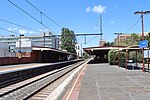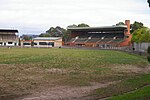Swinburne Senior Secondary College
1913 establishments in AustraliaEducational institutions established in 1913Public high schools in MelbourneVictoria (Australia) school stubs
Swinburne Senior Secondary College is a co-educational government secondary college located at 505 Burwood Road Hawthorn Victoria which caters for Years 11 and 12 students. The College offers Victorian Certificate of Education (VCE), Vocational Education and Training (VET) and Victorian Certificate of Applied Learning (VCAL).
Excerpt from the Wikipedia article Swinburne Senior Secondary College (License: CC BY-SA 3.0, Authors).Swinburne Senior Secondary College
Burwood Road, Melbourne Hawthorn
Geographical coordinates (GPS) Address External links Nearby Places Show on map
Geographical coordinates (GPS)
| Latitude | Longitude |
|---|---|
| N -37.822777777778 ° | E 145.04138888889 ° |
Address
Swinburne Senior Secondary College
Burwood Road 505
3122 Melbourne, Hawthorn
Victoria, Australia
Open on Google Maps








